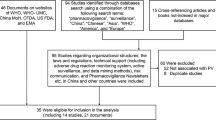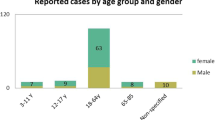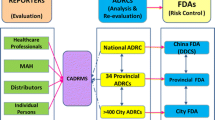Abstract
Objective
To ascertain if monitoring over-the-counter (OTC) drug sales could provide a timely syndromic surveillance method of detecting outbreaks of gastrointestinal illness.
Method
This study evaluated the potential of a syndromic surveillance system by comparing retrospective pharmacy OTC sales of anti-nauseants and anti-diarrheals to emergency room visits and case numbers from two Canadian outbreaks related to water contamination by Cryptosporidium, and E.coli O157:H7 and Campylobacter.
Results
Local sales trends of weekly aggregate OTC products were comparable to the outbreak epidemic curves. Statistical control tests on the sales data indicated the start of the outbreak periods.
Conclusions
An automated monitoring tool based on spatial and temporal trend analyses of daily OTC sales would provide supplemental community health information for public health officials that is timelier than currently available laboratory-based surveillance systems.
Résumé
Objectif
Vérifier si la surveillance des ventes de médicaments en vente libre pourrait être une méthode de surveillance syndromique opportune en vue de détecter les éclosions de maladies gastro-intestinales.
Méthode
Nous avons évalué les possibilités d’un système de surveillance syndromique en comparant les ventes rétrospectives d’antinauséeux et d’antidiarrhéiques vendus librement en pharmacie aux visites en salles d’urgence et au nombre de cas associés à deux éclosions au Canada liées à la contamination de l’eau par Cryptosporidium, et par E.coli O157:H7 et Campylobacter.
Résultats
Les tendances des ventes locales hebdomadaires de produits en vente libre suivaient les courbes des flambées épidémiques. Des contrôles statistiques des chiffres de vente ont indiqué le début des périodes d’éclosion.
Conclusion
Un outil de surveillance automatique basé sur l’analyse des tendances spatiales et temporelles des ventes quotidiennes de médicaments en vente libre fournirait aux agents de santé publique des renseignements supplémentaires sur la santé communautaire plus à jour que les systèmes de surveillance actuellement utilisés par les laboratoires.
Similar content being viewed by others
References
Hoogenboom-Verdegaal AMM, De Jong JC, During M, Hoogenveen R, Hoekstra JA. Community-based study of the incidence of gastrointestinal diseases in the Netherlands. Epidemiol Infect 1994;112:481–87.
Wheeler JG, Sethi D, Cowden JM, Wall PG, Rodrigues LC, Tompkins DS, et al. Study of infectious intestinal disease in England: Rates in the community, presenting to general practice, and reported to national surveillance. Br Med J 1999;318:1046–50.
Sethi D, Wheeler J, Rodrigues LC, Fox S, Roderick PJ. Investigation of under-ascertainment in epidemiological studies based in general practice. Int J Epidemiol 1999;28(1):106–12.
Lewis MD, Pavlin JA, Mansfield JL, O’Brien S, Boomsma LG, Elbert Y, Kelley PW. Disease outbreak detection system using syndromic data in the Greater Washington DC area. Am J Prev Med 2002;23(3):180–86.
Lazarus R, Kleinman KP, Dashevsky I, DeMaria A, Platt R. Using automated medical records for rapid identification of illness syndromes (syndromic surveillance): The example of lower respiratory infection. BMC Pub Health 2001;1(1):9.
Stirling R, Aramini J, Ellis A, Lim G, Meyers R, Fleury M, Werker D. North Battleford, Saskatchewan Spring 2001 Waterborne Cryptosporidiosis Outbreak. Health Canada Report, 2001. (https://doi.org/www.health.gov.sk.ca/info_center_pub_health_can_epi_report_NB.pdf)
Bruce Grey-Owen Sound Health Unit and M. McQuigge. The Investigative Report on the Walkerton Outbreak of Waterborne Gastroenteritis, May–June 2000.
SAS Institute Inc. SAS/STAT User’s Guide, Version 8, Cary, NC: SAS Institute, 1999.
O’Brien SJ, Christie P. Do CuSums have a role in routine communicable disease surveillance? Pub Health 1997;111:255–58.
Montgomery DC. Introduction to Statistical Quality Control. New York, NY: John Wiley and Sons, 1985.
Tillet HE, Spencer I. Influenza surveillance in England and Wales using routine statistics. J Hyg 1982;88:83–94.
Frost F, Craun GF, Calderon R. Waterborne disease surveillance. J Am Water Works Assoc 1996;September:66–78.
Melnychuk D, Moride Y, Abenhaim L. Monitoring of drug utilization in public health surveillance activities: A conceptual framework. Can J Public Health 1993;84(1):45–49.
Padiglione A, Fairley CK. Early detection of outbreaks of waterborne gastroenteritis. Water 1998; November: 11–15.
Rodman JS, Frost F, Davis-Burchat L, Fraser D, Langer J, Jakubowkski W. Pharmaceutical sales — A method of disease surveillance? Environ Health 1997;Nov:8–14.
Proctor ME, Blair KA, Davis JP. Surveillance data for waterborne illness detection: An assessment following a massive waterborne outbreak of Cryptosporidium infection. Epidemiol Infect 1998;120:43–54.
Hutwagner LC, Maloney EK, Bean NH, Slutsker L, Martin SM. Using laboratory-based surveillance data for prevention: An algorithm for detecting Salmonella outbreaks. Emerg Infect Dis 1997;3(3):395–400.
Hutwagner L, Thompson W, Seeman GM, Treadwell T. The bioterrorism preparedness and response early aberration reporting system (EARS). J Urban Health 2003;80(2,suppl 1):i89–i96.
Talbot T, Emde K, Gammie L, Mainiero J, Gelfreich E, Barry A, et al. Guidance Manual on Waterborne Gastrointestinal Disease Outbreak Detection. Amer Water Works Assoc 2001;90871.
Author information
Authors and Affiliations
Corresponding author
Rights and permissions
About this article
Cite this article
Edge, V.L., Pollari, F., Lim, G. et al. Syndromic Surveillance of Gastrointestinal Illness Using Pharmacy Over-the-Counter Sales. Can J Public Health 95, 446–450 (2004). https://doi.org/10.1007/BF03403991
Received:
Accepted:
Published:
Issue Date:
DOI: https://doi.org/10.1007/BF03403991




